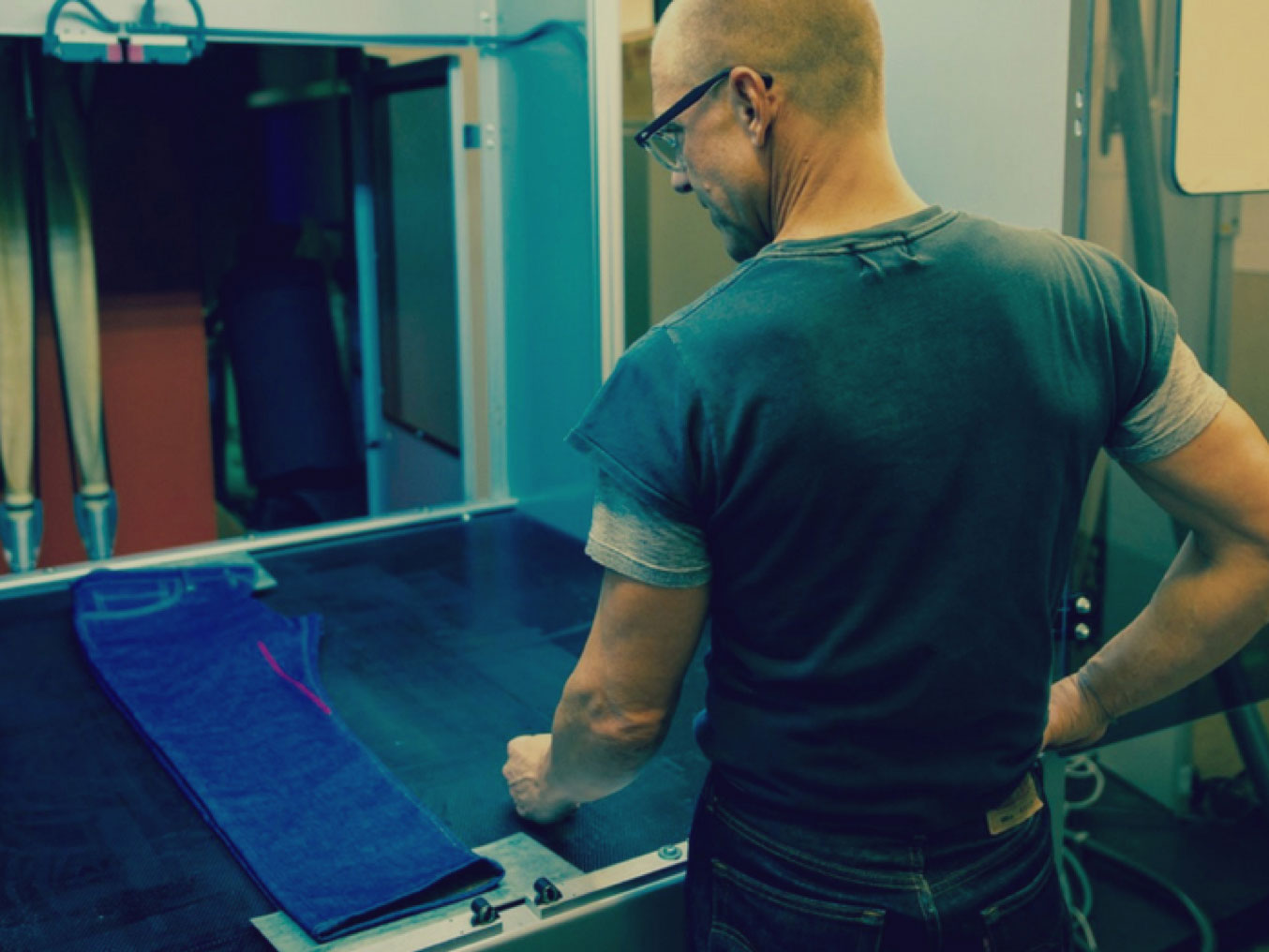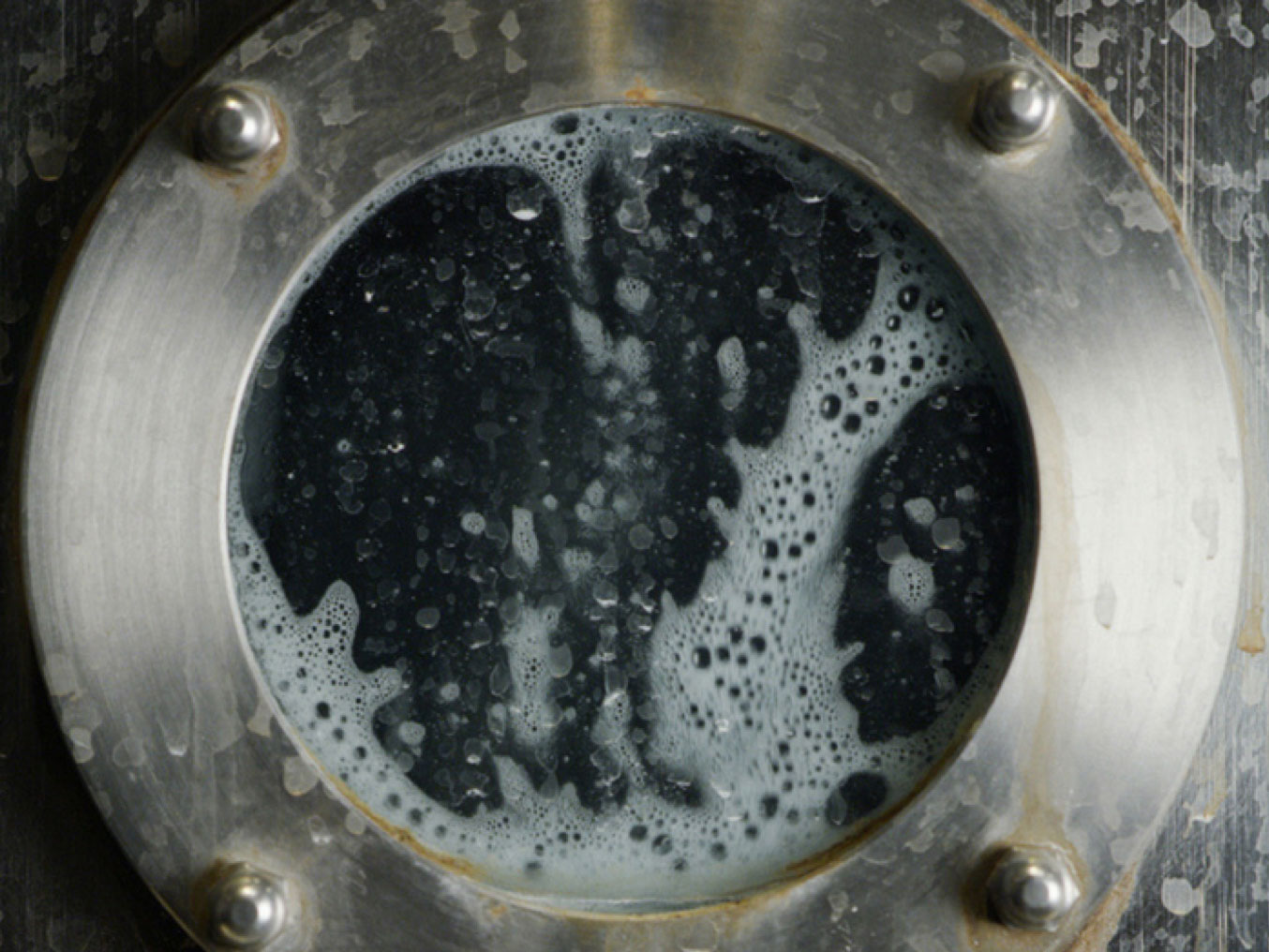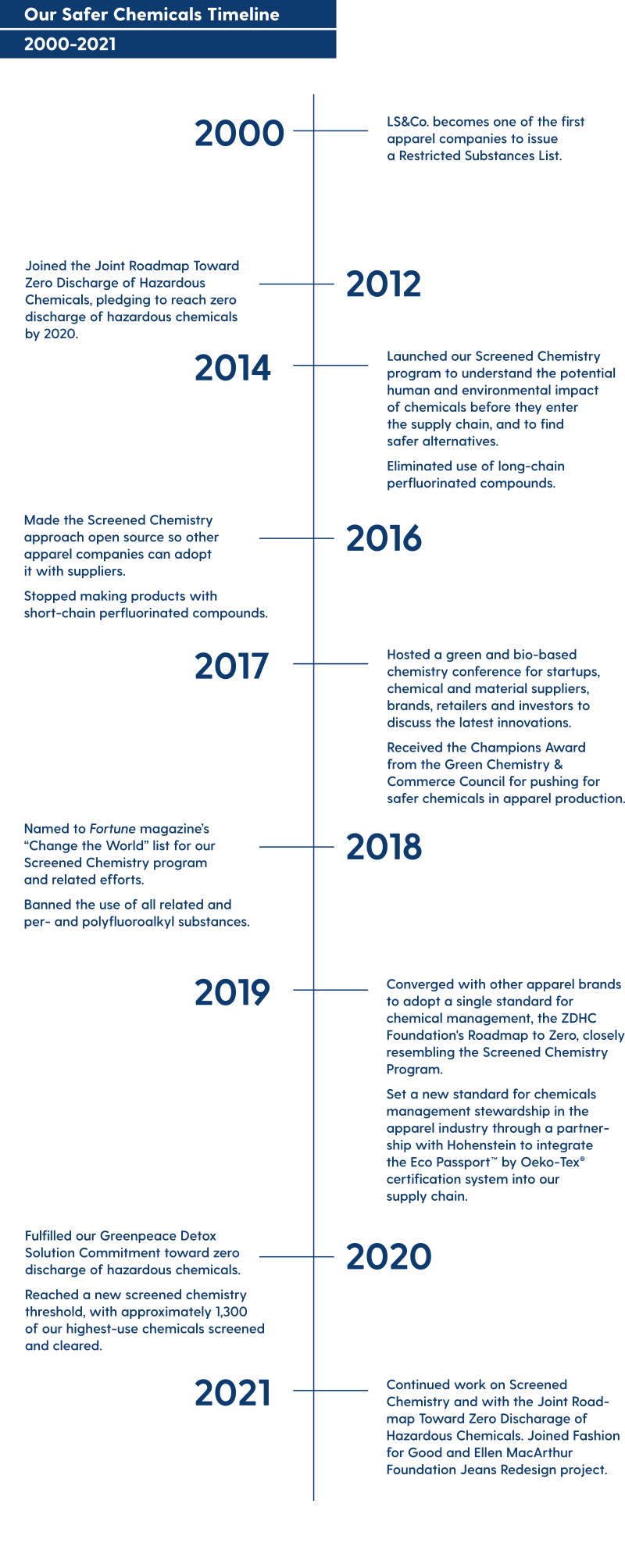A hazard-based approach to safer apparel chemistry
Textile mills use some 20,000 chemicals and are estimated to generate about 20% of the world’s industrial water pollution. To address this issue, we introduced wastewater effluent standards to the industry in the early 1990s. Then in 2000, LS&Co. was one of the first apparel companies to establish a Restricted Substances List (RSL), identifying chemicals that are restricted in the manufacturing of our products due to their potential effects on consumers, workers and the environment.
In 2012, LS&Co. joined the Joint Roadmap Toward Zero Discharge of Hazardous Chemicals (ZDHC), pledging to reach zero discharge of hazardous chemicals by 2020 — a set of goals we met and a major milestone for our chemical management program. The pioneering Screened Chemistry program we launched in 2014 is designed to understand the potential human and environmental hazards of chemicals before they enter the supply chain, and to help us find safer and more sustainable alternatives.
Along this journey to sustainable chemical management, we have tried to play a central role in helping shift the apparel industry from a reactive system focused on products and RSL testing, to a more proactive approach that manages input chemistry through the Screened Chemistry program and the ZDHC Manufacturing Restricted Substances List (MRSL). Focusing on chemical inputs allows us to select the safest chemical options and better control options for the supply chain. This eliminates hazardous chemicals from consideration before they even get to manufacturing facilities.
With our suppliers, we have established an effective system to monitor chemicals going into our production processes. And we have moved from a risk-based evaluation of chemicals to one based on hazards. We also measure chemical output through factory wastewater testing, but believe controlling chemical inputs is the best approach to ensuring more sustainable chemical management in the apparel supply chain, along with safer products and wastewater outputs.
Restricted Substances Stewardship Program
We launched the Restricted Substances Stewardship Program (RSSP) to ensure conformance with the ZDHC Roadmap and the successful elimination of priority chemicals, as identified by Greenpeace and ZDHC. The program provides guidance and a plan to eliminate priority chemical use and discharge, while supporting safe and responsible chemicals management.
Through the RSSP, LS&Co. requires manufacturing suppliers to prioritize responsible chemicals management. Our suppliers are required to work closely with chemical suppliers and analytical laboratories to ensure that responsible management extends throughout the supply chain. This provides us with transparency into program implementation and promotes accountability. LS&Co. checks on RSSP performance and compliance status monthly.
Since 2015, we have focused on implementing the program with suppliers and aligning the RSSP with the ZDHC MRSL. We also have focused on other tools and trainings developed within the ZDHC Roadmap. We believe in industry collaboration to bring scale and scope to our commitment to zero discharge of hazardous chemicals.
From Chemical Risk to Chemical Hazard
Although the words are sometimes used synonymously, hazard refers to a substance’s inherent properties that make it capable of causing harm to human health or the environment. Risk, on the other hand, is the possibility or likelihood of a harmful event coming from exposure to a substance. That’s why we see preventing hazards as the right approach to chemical management.
As part of our continued evolution in sourcing the safest possible chemicals in our supply chain, the Screened Chemistry system was designed to shift us and our suppliers from a risk-based to a hazard-based chemical management approach. Since 2014, we have been evaluating chemical formulations from a hazard lens with the help of third-party toxicology experts. This includes looking at the full material disclosure of chemical compounds in a given substance to make the right selection. Screened Chemistry allows us to validate all incoming chemicals through hazard assessment and make sure they are free of harmful substances. This is in contrast to the risk-based approach, which does not require full disclosure and can only reduce the likelihood of negative outcomes and unsafe outputs at the end of the wastewater pipeline.
Our RSL and the ZDHC MRSL indicate chemicals that are banned or limited to a certain threshold in our products and in our manufacturing processes, respectively. But for the effective elimination of restricted substances from supplier sources, materials and products, we also consider the hazards posed by full chemical formulation disclosures through the Screened Chemistry program.
Screened Chemistry
LS&Co.’s pioneering Screened Chemistry program examines chemicals used to manufacture our products against specific health and environmental impacts, allowing us to identify better alternatives and areas for innovation. Over the past five years, about 150 factories in the LS&Co. supply chain used our preferred chemicals list, which represents safer alternatives for manufacturing, and the aim is for all LS&Co. suppliers to use the preferred chemical list. This is a much more proactive approach to sustainable chemicals management in the industry, and one that we open sourced to benefit the entire supply chain.
To date, we have screened and cleared approximately 1,300 of our highest-use chemicals. Screening was performed by a toxicologist, validating RSL and ZDHC MRSL compliance as well as ensuring full material disclosure of the chemical formulation. We have shared the Screened Chemistry program with others in the industry and with the ZDHC Foundation, which is working on adopting the program as part of the ZDHC Aspirational Chemical Management level. As a result, other brands are now piloting the program with their suppliers.
Importantly, the Screened Chemistry approach exceeds legal requirements for chemical safety. It also includes commodity chemicals — the bulk chemicals that serve as building blocks in chemical processes and are the largest volume of chemicals used in apparel supply chains. Including commodity chemicals in the Screened Chemistry approach is a breakthrough for our supply chain. The commodity chemicals used in the apparel industry sometimes come from other industries, such as pharmaceuticals, and can contain impurities, residuals or contaminants from those other industrial uses. Under the Screened Chemistry process, any impurity or addition to a chemical must be disclosed and meet the ZDHC MRSL. This comprehensive and thorough approach is the first of its kind in the apparel industry.
The program screens impurities down to 100 parts per million. For example, in our F.L.X. program, this means that if a compound offers 99.99% purity, but the 0.01% includes a component we have screened out, we do not accept that chemical. All F.L.X. chemicals must be 100% Screened Chemistry conformant.
F.L.X. Reduces Chemicals
Through our game-changing operating model known as Project F.L.X., we are replacing manual techniques and digitizing the jeans-finishing process, allowing us to reduce the number of chemical formulations used in finishing from thousands to a few dozen. This is a major step in upholding our ZDHC commitment.
F.L.X. Reduces Chemicals
Through our game-changing operating model known as Project F.L.X., we are replacing manual techniques and digitizing the jeans-finishing process, allowing us to reduce the number of chemical formulations used in finishing from thousands to a few dozen. This is a major step in upholding our ZDHC commitment.
CleanChain Tool
Third-party toxicologists upload Screened Chemistry certificates to the CleanChain tool, where they can be accessed by our key suppliers. As of mid-2021, 108 factories in our supply chain are uploading their chemical purchases and deliveries. This allows us to see the chemicals used, by weight or volume, on a monthly basis in those factories. This tool allows us to have an outsized impact on safer chemical management beyond our own products, as our shared suppliers apply many of these preferred chemicals to the garments they produce for other, non-LS&Co. brands.
In Search of Scalable Botanical Dyes
Botanical, or plant-based, dyes offer potential as alternatives to synthetic chemical dyes. LS&Co. has tested the use of a variety of botanical dyes, but we have generally found they produce wide variations in color, in part because there is no non-chemical color fixing agent available to lock in a desired level of color saturation. While this might be acceptable for very small clothing lines, such as capsule collections, customers generally prefer to know the color jeans, jackets or tops they order will be in the color they chose. In 2020, we vetted botanical dyestuff and dyeing processes to evaluate some of their environmental benefits compared to conventional dye processes and feedstock. We determined that botanical dyes and process can save as much as 50% in water use than conventional processes.
In Search of Scalable Botanical Dyes
Botanical, or plant-based, dyes offer potential as alternatives to synthetic chemical dyes. LS&Co. has tested the use of a variety of botanical dyes, but we have generally found they produce wide variations in color, in part because there is no non-chemical color fixing agent available to lock in a desired level of color saturation. While this might be acceptable for very small clothing lines, such as capsule collections, customers generally prefer to know the color jeans, jackets or tops they order will be in the color they chose. In 2020, we vetted botanical dyestuff and dyeing processes to evaluate some of their environmental benefits compared to conventional dye processes and feedstock. We determined that botanical dyes and process can save as much as 50% in water use than conventional processes.
Zero Liquid Discharge
The Zero Liquid Discharge (ZLD) program is a government waste management program in India. Participating factories must either recycle or dispose of sludge in a government-controlled landfill. Most choose to recycle their sludge onsite with the approval of government authorities. Nine factories in the LS&Co. supply chain have earned the ZLD designation.
Zero Liquid Discharge
The Zero Liquid Discharge (ZLD) program is a government waste management program in India. Participating factories must either recycle or dispose of sludge in a government-controlled landfill. Most choose to recycle their sludge onsite with the approval of government authorities. Nine factories in the LS&Co. supply chain have earned the ZLD designation.
Partnerships for Progress
Over the past two years, we also announced key partnerships to strengthen the program and prevent chemical hazards from entering apparel supply chains:
- We partnered with the Hohenstein Institute to use the Eco Passport™ by Oeko-Tex®* certification system to enable enhanced testing, verification and transparency to chemical suppliers.
- We collaborated with two companies working toward sustainable chemicals management, Scivera and NimkarTek Laboratory, to pioneer cutting-edge approaches to screen and track bulk commodity chemicals in apparel supply chains.
*Oeko-Tex® is a registered trademark of ÖTI – Institut Für Ökologie, Technik und Innovation GmbH.
Safer Chemicals, Safer Products
LS&Co. is committed to responsible chemical management and to driving sustainable progress within the apparel industry. Safer chemical use is fundamental to ensuring the safety of our products. As of January 1, 2016, LS&Co. stopped producing products with any perfluorinated compounds (PFCs) —chemicals that can make materials waterproof and stain resistant. We extended the ban to cover short-chain fluorinated compounds in 2018. Our ban on PFCs and per- and polyfluoroalkyl substances is significant, considering there are currently no equally effective water- and stain-repelling alternatives.
The LS&Co. RSL prohibits the use of priority chemicals, including alkyl phenol ethoxylates, phthalates, short- and medium-chained chlorinated paraffins, flame retardants and others. We are also taking measures to fully enforce our ban on alkyl phenol ethoxylates — chemicals used in some detergents and surfactants. Suppliers are not allowed to intentionally use these banned chemicals in LS&Co. products.
In addition to ensuring suppliers adhere to the Screened Chemistry program and encouraging them to use chemicals from our preferred list, we also conduct testing on finished garments. This includes product testing for chemicals as well as mechanical and construction characteristics, such as flammability and various product safety requirements for children’s wear. Globally, LS&Co. is consistent in demonstrating the utmost product safety compliance with regulatory requirements. We experienced no safety non-compliances or recalls from 2018 to 2020.
2020 Highlights
- 1,300 chemicals on the LS&Co. Preferred Chemical List
- 108 factories use LS&Co.’s Preferred Chemical List and report chemical use to CleanChain tool
- Nine Zero Liquid Discharge factories in India, Bangladesh and Pakistan
2020 Highlights
- 1,300 chemicals on the LS&Co. Preferred Chemical List
- 108 factories use LS&Co.’s Preferred Chemical List and report chemical use to CleanChain tool
- Nine Zero Liquid Discharge factories in India, Bangladesh and Pakistan
What’s Next – Safer Chemicals
We remain as committed as ever to advancing more sustainable chemicals management. Above and beyond our 2020 commitments, we will continue to advance strategies, programs and collaborative efforts with key partners to develop and scale chemicals management across the apparel sector. This includes continuing to partner with ZDHC and fellow member organizations to create more sustainable change at scale, eliminate hazardous chemical use and improve wastewater treatment practices across the industry. We will also continue our collaboration with the Hohenstein Institute to use the Eco Passport™ by Oeko-Tex® certification system to better implement our chemicals management processes and create a template for the apparel industry.























